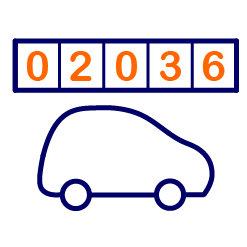Depreciation and Residual Value Guide
If you're thinking about buying or leasing your next car, you may want to consider how well the vehicle will retain its value, otherwise known as the residual value or depreciation rate.
But what exactly is residual value, how it is calculated, and why is it important? To help explain how residual value and depreciation works, car leasing experts, Nationwide Vehicle Contracts, has put together a comprehensive guide, including:

Put simply, there is little difference between depreciation and residual value. Both refer to the value of the car at the end of the lease term, however, depreciation may be calculated on an annual basis, whereas residual value typically refers to the value at the end of the contract.
The residual value of a car or van is important because it is an effective way for lenders to calculate which vehicles retain their value the best. To do this, lenders take into consideration the original value of the car and any expected depreciation.
Almost all cars depreciate over time, but it is estimated that a brand-new car will lose around 60% of its value over three years. As the depreciation rate of a vehicle directly affects its residual value, you can help cut costs by picking a car that is more likely to retain its value, whether you're buying or leasing.
Along with interest rate and tax, the residual value of a vehicle is a key factor in determining your monthly rental cost. This is because your monthly rentals are largely determined by the difference between the vehicle's purchase price and the estimated final sale price.
If you choose a high residual value car, the difference between the purchase price and the residual value will be smaller, resulting in lower monthly rentals. Conversely, a lower residual value increases the total amount you owe on the lease, leading to higher monthly rentals.
As we mentioned before, it is estimated that a brand-new car will lose around 60% of its value over three years. Generally, a good residual value is 55%-65% of the manufacturer's suggested retail price (MSRP).
“The residual value of a vehicle is one of the most important aspects when calculating the terms of a lease, as it affects the monthly rentals you will pay.”

The estimated residual value of a vehicle is calculated at the start of the lease agreement by the finance provider. It is typically calculated as a percentage of the vehicle's list price, also known as the manufacturer's suggested retail price (MSRP).
Factors that influence depreciation and residual value:

Vehicle age
Typically, the newer a car is, the faster it depreciates. It is estimated that once a vehicle reaches five years old, the depreciation rate slows right down. After around eight years, the car will have depreciated almost as much as it's ever likely to. Of course, in rare cases, popular or classic cars may bounce back in price further down the line.

Fuel efficiency
One of the most prominent considerations when buying a new car is how fuel-efficient it is. More people are interested in using a vehicle that is cheaper to run, so there is increased demand for vehicles that boast high rates of fuel economy. This increased demand drives up prices and slows down depreciation rates.

Vehicle mileage
The more miles a car has done, the more its value depreciates. For example, a vehicle that is three years old and has only done 15,000 miles will be worth more than one the same age that has done 60,000 miles. The greater the mileage on the car, the more likely there is to be wear and tear on the vehicle's components, leading to repairs or replacement.

Condition of the vehicle
If your car is in a sound, clean condition, it stands to reason that it will reach a higher sale price than one of the same age that is covered in dents, scratches and rust. This is why lease vehicles with a maintenance contract typically have a higher residual value because they are more likely to be maintained to a higher standard.

Demand and supply
The more in demand a vehicle is, the slower it will depreciate. Demand is influenced by an almost endless list of factors, including exclusivity, limited edition runs, fuel economy, reputation and brand popularity.

New model releases
Every so often, car manufacturers release new models of their vehicle. A brand new model is likely to depreciate slower than a model that is soon to be replaced by an updated version.

Popularity
When setting the residual value of a vehicle, finance providers will consider how many of the same model they have on their books. If they feel they'll struggle to sell a car at the end of the lease contract, they may increase the monthly rentals as a consequence. On the flip side, if the finance provider feels a vehicle will be easier to sell at the end of the contract, they may drop the prices to make the deal more attractive to lease customers.
It is important to note that while the above factors are certainly considered, residual values can vary between finance providers for the same vehicle. This is because different finance companies have different appetites for risk.
Here at Nationwide Vehicle Contracts, our busy pricing team compares the residual values for our lease vehicles across a panel of finance providers to ensure you the best deal on your lease car. You can read more in our How Car Lease Payments are Calculated guide.
The residual value of a vehicle can be difficult to determine as it depends on several factors. To work out the residual value for your car, you'll need to find out the vehicle's estimated depreciation value, along with the original value or manufacturer's suggested retail price (MSRP).
To find out the manufacturer's suggested retail price (MSRP) of a vehicle, you can visit the manufacturer's website or look back at your lease documentation to see if the on-the-road (OTR) price is listed.
To calculate the vehicle's estimated depreciation value, you'll need to know specific information about the car, such as the exact make, model, year and trim type, along with information about its initial condition, age and mileage. Some manufacturers, such as Volkswagen, allow you to compare residual values between their model range. For others, you may need to use a tool such as CAP HPI's Gold Book to determine the estimated vehicle value for up to five years.
Once you have worked out the vehicle's estimated depreciation value, you can use the below calculation to work out the estimated residual value of the car.
Original Value - Depreciated Value = Estimated Residual Value |
|---|
NB: All of the calculations made are estimates, as precise predictions and changes to the market cannot be made.
Once you've got your hands on your new car, looking after it properly can also help slow depreciation down.
How to choose the right car

Choose colours carefully
Stick with constantly popular colours like silver, black and blues, rather than whatever shades that are fashionable at the time.

Choose a fuel-efficient model
It is important to choose a model that will give you good fuel efficiency, especially with new government regulations impacting costs on new vehicles.

Choose a new and popular model
As we've discussed before, the higher the demand, the higher the price the vehicle will achieve.

Haggle when you purchase
If buying your car, the more money you save at the outset, the less you stand to lose when selling the vehicle.

Look after the vehicle
Keep the car clean and well maintained – regularly wash it, tackle any rust spots early, and periodically check things like oil levels, water levels and tyre pressures.

Reduce unnecessary journeys
Keeping your mileage down will slow depreciation.

Maintain the vehicle
Service your car according to the manufacturer's schedule and keep a record – dealership stamps in a vehicle's service history book go a long way to assuring people the car has been well looked after.

Deal with repairs quickly
Carry out any repairs quickly and properly or consider taking out SMART insurance to protect from minor damage, such as small scratches, scuffs and dents.
If you're interested in leasing a vehicle, view our latest car leasing deals, or give us a call on 0345 811 9595 to discuss your options.
Guide Information
Originally published: 19th October 2015
Last updated: 15th April 2021
